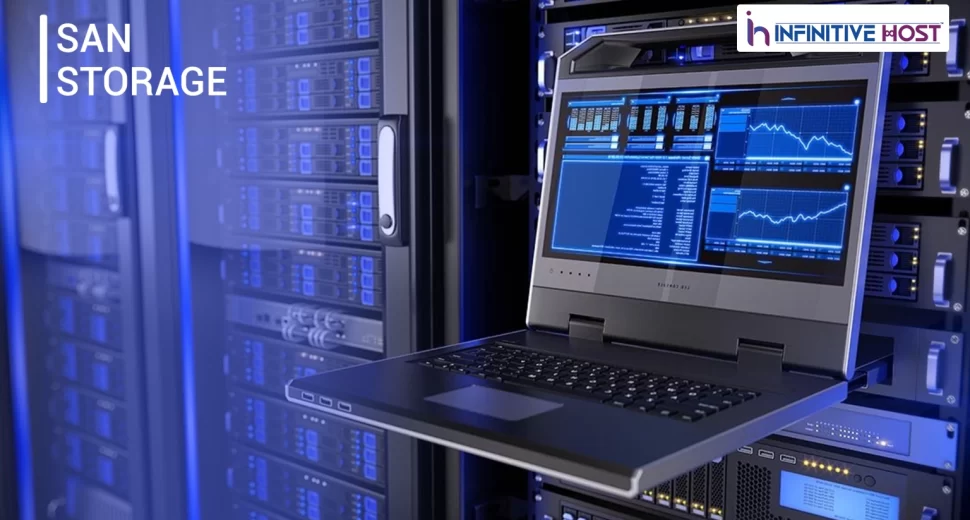To store information in a centralised location, a “Storage Area Network” (or “SAN”) is necessary. SAN as the name suggests is a high-speed network that is specifically designed for storing data. Servers, switches, optic cables, and hard drives all contribute to the infrastructure of this network. In this architecture, the data storage units are separated from the servers.
Instead, switches connect the storage devices to the servers. And the connection is made with optical fibres. As a result, a SAN can transfer data at a breakneck pace. Because of this, the hosted information and storage devices appear to the server and its operating system as if they were simply other local drives.
Also, despite the presence of numerous servers and storage devices, users of a SAN will only have access to consolidated data and block-level operations. SAN has its benefits and drawbacks too, just like any other data storage option. The article will discuss some of the advantages and disadvantages of using SAN (Storage Area Network).
Read More : What Is SMTP Mail Delivery? How It Is Beneficial For Business
Advantages of using SAN
Security
SAN is the way to go if you care about data security. A SAN allows for flexible implementation of security measures of varying types. For instance, with the help of a virtual SAN, you can create separate networks for different users, companies, or even individual departments.
Similarly, you can restrict access to only authenticated users by configuring an ACL (Access Control List) on the switches themselves. There are many other options for securing the SAN, so don’t feel limited by these. If that’s the case, then rest assured that the SAN’s data will remain safe at all times.
Accelerated Information Processing
If you’re fed up with the sluggishness of your storage network and storage devices, SAN is exactly what you need. Data transfer rates of over 5 Gbps are possible with SAN technology, thanks to the use of fiber optics. The rate of data transfer is extremely high, making it one of the most advanced network technologies available today.
Dynamic Protection
Dynamic Protection even if some of the servers are down, it will not affect the service. In the event of a server failure, the automatic traffic rerouting feature and the built-in redundancy would take over. As a result, your data storage infrastructure won’t ever go down. When you need to perform maintenance on one of the servers, this dynamic fail over protection comes in handy.
Centralised Backup
Centralised Backup, More importantly, a SAN stores all of its data in one place. As a result, the data will be automatically replicated and stored in a centralised repository. This means that if one server in the network goes down, the others will step in and keep the data flowing smoothly. This https://www.infinitivehost.com/cloud-vps/?utm_source=blog&utm_medium=cloudvpsbanner1means there is no disruption to data transfer over the SAN.
Improved Backup Time and Cost
Now you know that SAN’s backups are handled in one centralised location. Using consolidated backup technology, the entire data-backup procedure can be automated. That way, you can rest assured that your storage network’s data is being backed up quickly and reliably. It is also the most cost-effective storage network option available. Therefore, if you find that it is taking too much time to take backups of your data and you would like to speed up the process, you can use a SAN or Storage Area Network.
Improved Disk Usage
Better disc management is another major perk of SAN. With a consolidated storage network connecting all of the storage arrays, they can be handled collectively. Consequently, you can control and allocate the storage resources for specific servers in the network. Without a SAN, you would need to buy many separate storage discs and install them on servers one by one. Disk management problems are avoided when a SAN is used.
Superb Recovery from Catastrophe
You can set up state-of-the-art DR infrastructure in a SAN center. When it comes to backing up your data, a SAN’s secondary storage array is your best bet. As a result, you can rest assured that your data is always safeguarded and can be quickly restored in the event of a disaster. The implementation of a disaster recovery system for a SAN is costly, however. If you implement disaster recovery, however, you can retrieve all of the lost data with the click of a button.
Increased Availability of Your Data and Programs
Storage area networks (SANs) are built so that they can function without ever failing. Many different redundant safeguards are implemented in this network storage technology to ensure the security of your files. This means that you and your business will have continuous access to all of the information and programs you require. Because SAN employs the most advanced algorithm available, you can rest assured that your data is secure and consistent at all times.
Disadvantages of using SAN
The Cost May Be Too Much for Some People
The truth is that it costs a lot of money to keep a storage area network running smoothly. The reason is that you’ll be receiving access to a state-of-the-art data center. Therefore, SAN is not necessary if your company is small. You can instead try to find alternate low-cost options.
The Risk of Information Disclosure
Safeguarding the SAN is something that should always be done. However, it can be costly to add robust security to a SAN. As a result, a large number of people avoid them. All of the client computers in a SAN share the same storage devices and servers; without proper security measures in place, sensitive data could be compromised.
Read More : What Is Squid Proxy Server?
Conclusion
Information commuting to and from a SAN uses a separate network from regular user traffic, backup data, and other SAN traffic. The number of devices that can be connected to a SAN is effectively infinite.









